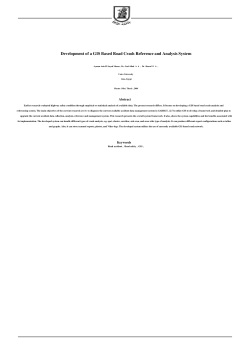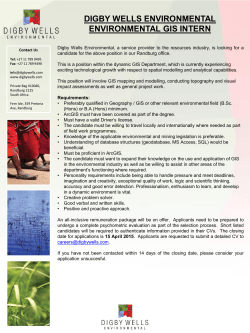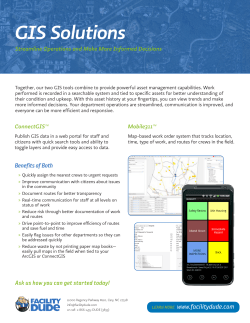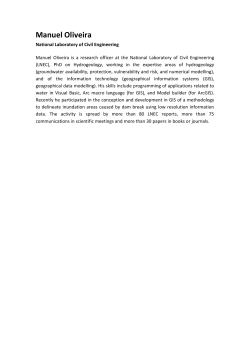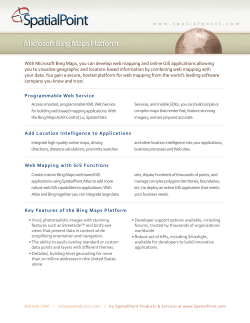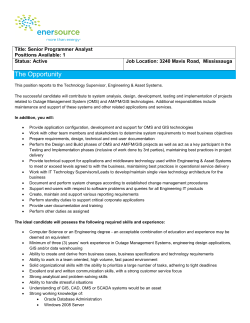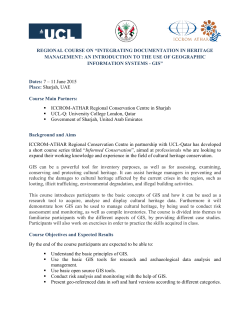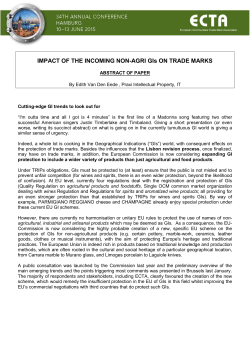
Presented at the NCGIS Conference, Raleigh, NC 2015 by: David
Presented at the NCGIS Conference, Raleigh, NC 2015 by: David Toren MapForsyth Discussion Points Who/what is MapForsyth? GIS in Public Health Epidemiology Public Assistance Crowdsourcing Methods and Technologies used for creation and distribution of GIS information Resources Who/What is MapForsyth? An Enterprise Geographic Information Office – established in 2011 Result of Countywide GIS Needs Assessment and Strategic Implementation Plan (completed in 2009) The goal of this initiative was to identify a strategy for improving business processes using GIS technology This strategy consist of sharing resources/assets, collaboration between the departments of the municipal governments and the county government Implement a shared system between Forsyth County, the City of Winston-Salem and all of the other municipal governments within the county GIS in Public Health Epidemiology Studies the patterns, causes, and effects of health and disease conditions in defined populations. The cornerstone of public health. Informs policy decisions by identifying risk factors for disease and targets for preventive healthcare. GIS in Public Health London Cholera Epidemic of 1854 John Snow (1813-1858) Wake Forest University Translational Science Institute Gun Violence as a Health Disparity (https://brsa.wakehealth.edu/community/what-we-do/gun-violence-as-a-health-disparity) “MapForsyth has supported several projects of the Program in Community Engagement at the Wake Forest medical school. Their use of GIS documented the association of gun violence with other health and social disparities in specific Winston-Salem neighborhoods. No other approach could provide this stark portrayal with such power. The ability of GIS to provide visual illustration of health and social issues lays an important foundation for planning and intervention.” Thomas A. Arcury, PhD Professor and Vice Chair for Research, Department of Family and Community Medicine Director, Program in Community Engagement, Wake Forest University Translational Science Institute Director, Center for Worker Heath Wake Forest School of Medicine Distressed Area Analysis Social Services Variables Adult Medicaid Child Medicaid Food Stamps Day Care Program Work First Program Property Variables Delinquent Real Property Foreclosures (bank) Structure Fires Code Violations (aggregated) Zoning Violations • Crime Variables – – – – – – – – – – Assault Burglary Copper Theft Drug Offenses Homicide Rape Robbery Suspicious Persons Trespassing Vandalism GIS in Public Health Public Assistance Provide departments and organizations that work with the public better tools to aid the population that they serve. Perform analysis of data to better define target areas for public outreach, education, etc. Quickly identify areas for potential grants. Provide information directly to the public. Tweet about this presentation #gispro2014 Buffering: • 1/8 Mile around a corner store Purpose: • To identify properties located new a corner store • To identify types of properties new the corner store ROI/Value: • Knowledge of properties near corner store • Ability to preform site visits • Education about health food • To decide whether or not to include corner store in grant for healthy foods Crowdsourcing “the practice of obtaining needed services, ideas, or content by soliciting contributions from a large group of people and especially from the online community rather than from traditional employees or suppliers” Source: Merriam-Webster. “Crowdsourcing.” http://www.merriam-webster.com/dictionary/crowdsourcing. Last Accessed 03 Feb. 2015 Crowdsourcing Example Run Keeper App .gpx ROI/ Value of Crowdsourcing Example Quick data collection Able to present proposed trail to Parks & Recreation and County Manager Multitasking (Time Saving) Regular run Data collection No investment in app or data collection device (i.e. smartphone) Methods and Technologies used for creation and distribution of GIS information Many different ways to get information to the people who can benefit from it: ArcGIS Online Web Maps Web Mapping Applications Open Data Sites Open Source Google Maps and APIs PostgreSQL Tried and True Email PDFs FTP Sites Hard Copies GIS in Public Health Resources URISA Journal of the Urban and Regional Information Systems Association Vol. 20 No. 2. 2008 Dedicated to “GIS in Public Health” Association of American Geographers (AAG) Annals of the Association of American Geographers Vol. 102 No. 5. 2012 Special Issue: “Geographies of Health” Book GIS and Public Health. 2012. 2nd Ed. Ellen K. Cromley and Sara L. McLafferty. The Guildord Press: NY Centers for Disease Control and Prevention Website (GIS at CDC): http://www.cdc.gov/gis/ Contact Information THANK YOU!! Dave Toren GIS Programmer dtoren@cityofws.org 336-703-2329 Please visit us at www.mapforsyth.org Follow us on Twitter: @MapForsyth
© Copyright 2025
